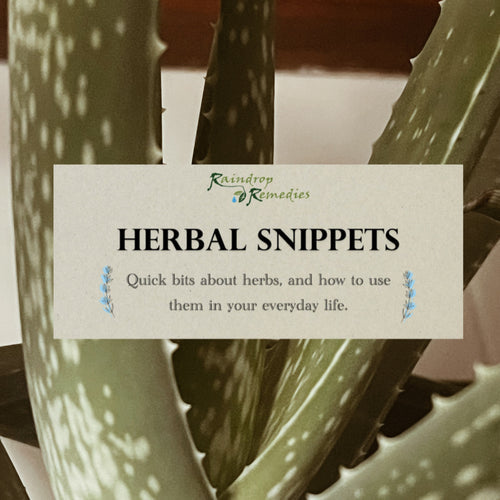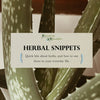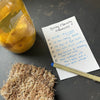Herbal Snippets: Aloe Vera

Aloe
Kingdom: Plantae | Family: Asphodelaceae | Genus: Aloe
Species: there are over 430 species of Aloe, with A. vera and A. xerox the most commonly used. 1
Energetics: Cooling, Moistening
Characteristics: Hydrating; soothing to irritated skin (emollient) and mucosal membranes (demulcent); anti-inflammatory; antiseptic; antibacterial; purgative (cathartic); vulnerary (healing)
Phytochemicals: Polysaccharides; phenolic acids; flavonoids; tannins; alkaloids; sterols; Vitamin E, C, B, folic acid, and more; amino acids; saponins; fatty acids; Anthraquinones; proteins 1, 2
The Anthraquinone Aloin is a stimulant laxative and causes peristaltic contractions. It is toxic at higher doses and with prolonged use. 3 The outer green portion of the leaf is strongly cathartic, so it should be avoided internally. 4
Latex is a milky, sticky fluid produced by plants that is used as a defense against predators, and also helps to seal and heal its own wounds. Aloe latex is found in the green outer layer and in the yellow-brown goop that is seen when cutting a leaf. People with allergic reactions to aloe may be reacting to these particular phytochemicals.
Aloe is typically regarded as safe when used appropriately.
Ways to Use: Aloe juice and gel are the most commonly used parts of the Aloe plant and are made from the inner pulp of the leaf. Aloe is best used fresh: it will require preservatives to keep for longer.
Aloe vera juice taken internally: aids in digestion by helping to cleanse and detox the digestive tract, and to provide relief of digestive issues like constipation and diarrhea. 2 With a healthier gut, immune function will also be improved. Caution must be taken of course with this route: too much can lead to blood sugar drops, lowered potassium levels, and dehydration.
Aloe is moisturizing and soothing to skin. Not only does it help with sunburns, but it can be helpful with psoriasis, warts, aging, wrinkles, insect bites, acne, and eczema. The polysaccharides in Aloe will bind moisture into the skin. The amino acids and zinc in Aloe can help to soften hardened skin too. 3
How to Use Fresh Aloe:
1. Remove a healthy leaf from the plant. Wash it with clean water and place the leaf upside down in a bowl or glass with a bit of water in it. Let sit overnight. This will drain off the Aloin and other bitter compounds mentioned previously.
2. Remove leaf and discard water. Place leaf on cutting board.
3. With a sharp thin knife, slice off the edges of the leaf. Slice off the top layer and discard. Carefully slice the bottom layer off, leaving you with the clear inner filet.
4. Now you are ready to use for skincare, tonics, and more!
Where do we use ALOE at Raindrop Remedies?: We use aloe in our handmade soaps, herbal-infused lotions, and face serums.
References
1 Naimu F, Oloro J, Kahwa I, Ogwang, P. Review on the phytochemistry and toxicological profiles of Aloe vera and Aloe ferox. Future Journal of Pharmaceutical Studies; 2021 Jul 21;7(1):145
2 Banik S, Sharangi AB. Phytochemistry, health benefits and toxicological profile of Aloe. J Pharmacog Phytochem. 2019;8(3):4499–4506
3 Rajeswari, R., Umadevi M, Sharmila CR, Selvavenkadesh SP, Kumar KPS, Bhowmik D. Aloe vera: The miracle plant - Its medicinal and traditional uses in India. Journal Functional Foods. 2016; 24:501-512
4 Easley T, Horne S. The Modern Herbal Dispensatory: A Medicine Making Guide. 2016





